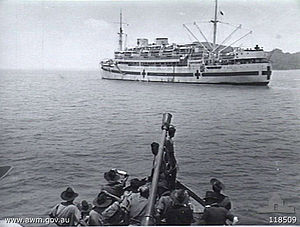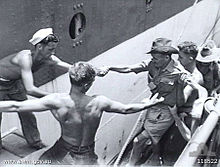MSWanganella
 Australian ex-POWs being transferred to the hospital shipWanganellatwo days after their liberation fromBatu Lintang camp,Kuching, Sarawak, on the island of Borneo in September 1945
| |
| History | |
|---|---|
| Name | Wanganella |
| Namesake | Wanganella, NSW |
| Owner | Huddart Parker |
| Port of registry | Melbourne |
| Route | Trans-Tasman |
| Builder | Harland and Wolff,Belfast |
| Yard number | 849 |
| Launched | 17 December 1929 |
| Completed | 29 November 1932 |
| In service | 12 January 1933 |
| Reclassified |
|
| Homeport | Melbourne |
| Identification |
|
| Fate | Scrapped in Taiwan in 1970 |
| General characteristics | |
| Type | Ocean liner |
| Tonnage | 9,576GRT,5,625NRT |
| Length | 461.2 ft (140.6 m) |
| Beam | 63.9 ft (19.5 m) |
| Draught | 7.6 m (25 ft)[citation needed] |
| Depth | 29.1 ft (8.9 m) |
| Installed power | 1,305NHP,6,750 bhp |
| Propulsion |
|
| Speed | 16.7 knots (30.9 km/h) |
| Capacity | 304 First Class, 104 Second Class |
| Crew | 160 |
| Sensors and processing systems | wirelessdirection finding |
MSWanganellawas an Australian-registeredocean linerbuilt byHarland and Wolffthat entered service on thetrans-Tasmanroute in 1933. Originally namedAchimota,she was acquired byHuddart Parkerafter the original sale toElder Dempster Linesfell through.
RenamedWanganella,the ship sailed between New Zealand and Australia until 1941, when she was converted into ahospital ship.AsAustralian Hospital Ship (AHS)Wanganella,the ship operated in support of Australian forces until 1946, when she was returned to her civilian operator. In the 1950s and 1960sWanganellawas affected by several incidents of industrial action by wharf labourers.
The increase in travel by air made operating the ship less viable, but before the ship was due to be scrapped in 1963, she was acquired and moored inDoubtful Sound,New Zealand, and used as a hostel for construction workers building theManapouri Power Stationuntil 1970. In April 1970, a tug towedWanganellato Hong Kong, then later Taiwan, where she was scrapped.
Building
[edit]
Harland and WolffbuiltWanganellaas yard number 849 on slip number five in itsBelfastyard, launched her on 17 December 1929 and completed her on 29 November 1932.[1][2]Elder Dempster Lines had ordered her asAchimotafor its West African trade.[1]But Elder Dempster was in financial trouble at the time and never took the ship over. Eventually the Melbourne-based Australian shipping companyHuddart ParkerboughtAchimotain September 1932 and renamed herWanganella,[3]beginning regular service on 12 January 1933.
Wanganellahad twinscrews,each driven by an eight-cylinder four-strokesingle-actingdiesel engine.Harland and Wolff built the engines under licence to aBurmeister & Waindesign.[1]Between them the two engines were rated at 1,305NHP[4]and gave her a service speed of 16.7 knots (30.9 km/h).[1]
Wanganellawas equipped with wirelessdirection finding.In 1934 hercode lettersLHVJ[4]were superseded by thecall signVJPQ.[5]
Operational history
[edit]Before World War II
[edit]RenamedWanganella,the ship was a top-rated trans-Tasman ocean liner, with berths for 304 first class and 104 second class passengers. She primarily sailed between the cities ofAucklandandWellingtonin New Zealand, and Sydney and Melbourne in Australia, crossing the Tasman Sea in three and a half days.

On 28 December 1937 she collided with the trawlerDurraweenoff the coast of New South Wales. On 19 June 1940 she helped to rescue passengers fromRMSNiagaraafter the latter hit a mine and sank off the coast of Auckland.[6]
Message in a bottle
[edit]On 11 September 1935, amessage in a bottlewas put in the ocean, reading:Thrown overboard by Mr & Mrs Robert Hare and son Billy 11/9/35 en route Syd/Auck.Will finder please communicate with above atBallarat,Vict – Aust, The City Beautiful, Largest inland city of the commonwealth.
This was discovered atFraser Island, Queensland,some 20 years later, but the message was forgotten until 2018 when the finder sought to research the senders of the message, including the Captain of the ship (Captain R Darrock), and a named witness (W Elsden-Dew). The message had been written on a menu card for an evening meal. The menu, dated Tuesday, 10 September 1935 was one day old when it was adorned with a handwritten note, placed into the cork-topped bottle, and thrown into the ocean.[7]Of note, Mr Robert Hare was Manager of the Huddart Parker Line of whichWanganellawas a part, and his son William (Billy) became a leading radiologist and Professor ofRadiologyat theUniversity of Melbourne.[8]
Hospital ship
[edit]During World War II,Wanganellawas converted to serve as an AustralianHospital Ship(AHS). Between 19 May 1941 and 1946, AHSWanganellacarried wounded and sick evacuees from the Middle East, New Guinea, Solomon Islands, Borneo and the South Pacific, travelling over 251,011 nautical miles (464,872 km) and transporting 13,385 wounded.[9]

A recently-liberated soldier fromBatu Lintang camp,Kuching, Sarawak wrote of her:
My first real sight of the hospital ship occurred at a range of well over a mile... Distances and sizes of things at sea can be very deceptive... [and] I realised she was far bigger in all respects than I had imagined.Wanganella,for such was her magic name, rode quietly at anchor unperturbed by wind or tide, unreal, dazzling white, clinically neat, a heavenly ship waiting patiently as a lover to receive us.... I swayed with the motion of theMTB.My liberator Massey laughed at my weakness but enthused, 'This is one hell of a good ship. You'll be alright nowcobber!' It seemed a contradiction in terms to callWanganella'a hell of a ship'; to me she appeared as a vessel from another world, but I understood his concern to reassure me that indeed there was now hope of a future for us all. The port side of the ship towered high above us. I viewed with dismay the formidable rank of steps leading from the launch to the main deck.... The slow energy sapping climb began. Each patient, for that was what we had become; was escorted by male Australian nurses. They were taking good care, that even as we had been snatched from under the Japanese heel, we should not fall now, and be claimed by the sea.... After an eternity of endeavour, advancing one step at a time, one by one we reached the deck. Behind me a voice avowed 'I would not like to have to do that all over again.' It was Slim Landers: I was not sure whether he meant the climb up the gangway or the three and a half years at Batu Lintang. "
— [10]
Post-war
[edit]On her maiden voyage after the war,Wanganellahad a narrow escape when she ran aground onBarrett Reef(later to claimTEVWahinewith 53 lives lost) at the entrance toWellington Harbourin New Zealand. On 19 January 1947, while making her first trans-Tasman voyage after the war,Wanganellastruck Barrett Reef just before midnight and stuck fast. The weather conditions were unusually benign, and remained so for the 18 days she spent on the reef. Such benign weather is still known in Wellington as "Wanganella weather". No-one was injured, and the passengers were taken off the ship the morning after the accident. The damage she incurred put her out of action for 22 months, mainly as a result of industrial action while she was laid up in a floating dock for repairs. Harland and Wolff sent out the necessary steelwork from Belfast.[3]

Wanganellawas caught up again in industrial action; this time in the1951 New Zealand waterfront dispute.This 151-day-long industrial battle between the employers and the watersiders in New Zealand began when watersiders refused to work overtime. The New Zealand Government, hand-in-glove with the employers, was determined to smash the union and introduced Emergency Regulations. The army was brought in to work the wharves.Wanganellabecame involved in smuggling money and manpower between Australia and New Zealand, with her Australian crew carrying thousands ofpoundsto New Zealand from various unions in Australia, in support of their New Zealand comrades.
In about 1960,Wanganellawas acquired by the scrap metal dealer Albert G Sims, and was sent to Singapore forbreaking up as scrap.However, there was a drop in scrap metal prices, and the ship returned to service on the Sydney to Auckland run. In early 1962, when the owners were taken over by McIlwraith McEacharn Ltd of Melbourne, the ship was sold to the Hang Fung Shipping & Trading Co Ltd of Hong Kong, operating under the same name.[3]
Hostel ship
[edit]
During the 1950s and 1960s, the expansion of civilian air travel made trans-Tasman shipping obsolete. In 1963, shortly before the ship was due to be scrapped, engineers working on the construction of theManapouri Power Stationin New Zealand acquiredWanganella.
Between 1963 and 1970,Wanganellawas moored inDoubtful Soundto be used as a hostel for workers building the tailrace tunnel, and the Wilmot Pass access road. The vessel became notorious for the drinking culture on board. A popular legend is when the vessel was to be towed away, tugs apparently struggled to dislodge the ship from a bed of empty beer cans that had been tossed overboard.
Wanganellawas sold for scrap in 1970, and was towed to Hong Kong, then Taiwan. The cove in whichWanganellawas moored and the stream that supplied the water to the liner are now gazetted as Wanganella Cove and Wanganella Stream.
References
[edit]Notes
[edit]- ^abcd"Wanganella".The Yard.Retrieved30 December2020.
- ^McCluskie 2013,p. 140.
- ^abcDunn 1964,pp. 76–77
- ^ab"Steamers & Motorships".Lloyd's Register(PDF).Vol. II. London: Lloyd's Register. 1934.Retrieved30 December2020– via Plimsoll Ship Data.
- ^"Steamers & Motorships".Lloyd's Register(PDF).Vol. II. London: Lloyd's Register. 1934.Retrieved30 December2020– via Plimsoll Ship Data.
- ^Waters 1951,p. 98.
- ^Message in a bottle mystery leads to hunt for author's family 80 years on,Hailey Renault,ABC News Online,19 February 2018
- ^"William Samuel Calhoun Hare AO, MBBS 1967".University of Melbourne.7 October 2016. Archived fromthe originalon 31 March 2018.Retrieved19 February2018.
- ^Smith 1992,p. 19.
- ^Ooi 1998,pp. 640–1 The author was LE Morris, who weighed five stone, three pounds (73 pounds (33 kg)) on his liberation
Bibliography
[edit]- Bell, Andrew; Robinson, Murray (2009).A Tasman Trio: Wanganella – Awatea – Monowai.London: Ships in Focus Publications.ISBN9781901703559.
- Dunn, Laurence (1964).Famous Liners of the Past Belfast Built.London: Adlard Coles.
- McCluskie, Tom (2013).The Rise and Fall of Harland and Wolff.Stroud: The History Press. p. 140.ISBN978-0752488615.
- Ooi, Keat Gin (1998).Japanese Empire in the Tropics: Selected Documents and Reports of the Japanese Period in Sarawak, Northwest Borneo, 1941–1945.Monographs in International Studies, SE Asia Series. Vol. 101 (2 vols). Ohio University Center for International Studies.ISBN0-89680-199-3.
- Smith, AE (May 1992) [1991].Three Minutes of Time – the torpedoing of the Australian Hospital Ship Centaur(Second Printing ed.). Miami: Tasman Press.ISBN0-646-07631-0.
- Waters, Sydney D (1951).Union Line A Short History of the Union Steam Ship Company of New Zealand Limited 1875–1951.
